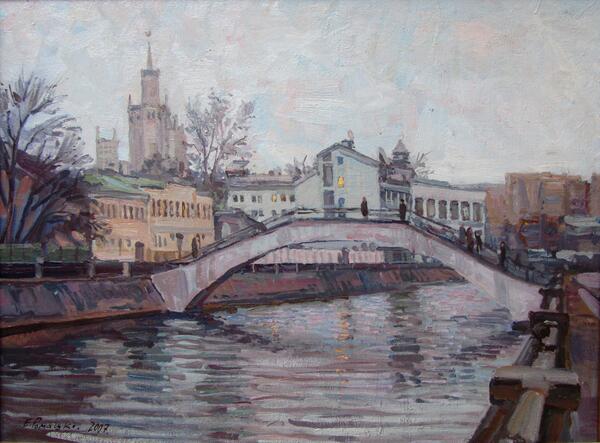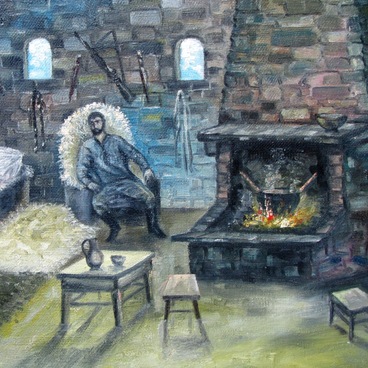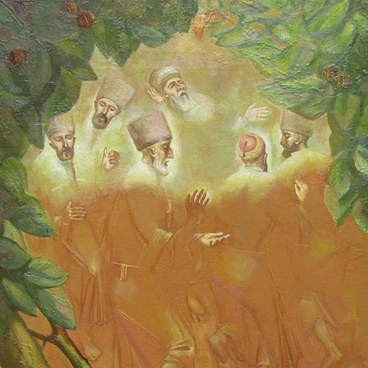The museum houses the painting “A Moscow Embankment” by Evgeny Romashko. On this canvas, the artist depicted a view of the Ozerkovskaya Embankment in the Russian capital. The middle plane of the painting is occupied by a stone arch bridge over the river and figures of seven pedestrians. In the left side of the background, one can see a high-rise building with a spire, one of Stalin’s skyscrapers.
The painting was created in a Realist style: as the artist depicted modern life within a historical context, which is indicated by the classical architecture of the city. The artist carefully built the composition and selected a harmonious color palette of muted light tones. Light and shade transitions, with which Romashko painted the river, make the image more dynamic.
In his landscapes of Central Russia, the artist depicts nature in different seasons of the year, often turning to complex transitional states like early spring and late autumn. Often in his canvases, nuances, subtle transitions of light and shadow, and the shades of color become the most important elements.
One of his favorite themes was the Russian winter. For example, in the painting “Quiet and Calm. Pereslavl-Zalessky”, the Old Russian architecture is organically integrated into nature and acts as an integral part of its quiet harmony.
A special place Romashko’s oeuvre is occupied by landscapes, which he created based on his impressions of travelling abroad. The artist visited France, Sweden, Montenegro, China and many other countries. In the paintings dedicated to them, the artist conveyed the mood and national peculiarities of these countries.
Evgeny Romashko was born on February 1, 1962 in the Ukrainian town of Zaporizhia. He finished the Taras Shevchenko Republican Secondary Art School in 1980. In 1985, Romashko continued his education, studying at the Moscow State Stroganov Academy of Industrial and Applied Arts.
The artist’s works are housed in museums in many Russian cities, as well as at the Alfredo Guati Rojo National Watercolor Museum in Mexico City, the Museum of Russian Art in Harbin, China, the collection of the Russian Cultural Foundation, and private collections in Russia and abroad.
The painting was created in a Realist style: as the artist depicted modern life within a historical context, which is indicated by the classical architecture of the city. The artist carefully built the composition and selected a harmonious color palette of muted light tones. Light and shade transitions, with which Romashko painted the river, make the image more dynamic.
In his landscapes of Central Russia, the artist depicts nature in different seasons of the year, often turning to complex transitional states like early spring and late autumn. Often in his canvases, nuances, subtle transitions of light and shadow, and the shades of color become the most important elements.
One of his favorite themes was the Russian winter. For example, in the painting “Quiet and Calm. Pereslavl-Zalessky”, the Old Russian architecture is organically integrated into nature and acts as an integral part of its quiet harmony.
A special place Romashko’s oeuvre is occupied by landscapes, which he created based on his impressions of travelling abroad. The artist visited France, Sweden, Montenegro, China and many other countries. In the paintings dedicated to them, the artist conveyed the mood and national peculiarities of these countries.
Evgeny Romashko was born on February 1, 1962 in the Ukrainian town of Zaporizhia. He finished the Taras Shevchenko Republican Secondary Art School in 1980. In 1985, Romashko continued his education, studying at the Moscow State Stroganov Academy of Industrial and Applied Arts.
The artist’s works are housed in museums in many Russian cities, as well as at the Alfredo Guati Rojo National Watercolor Museum in Mexico City, the Museum of Russian Art in Harbin, China, the collection of the Russian Cultural Foundation, and private collections in Russia and abroad.



